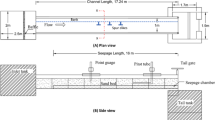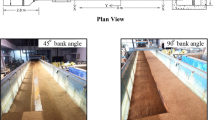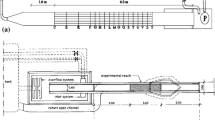Abstract
Accurate measurements and estimations of the river flow rate are essential elements for the effective management of water resources. The stage-discharge curve is a traditional method but it has limited applicability because of the loop form characteristics, which are caused by a tidal river, the backwater effect, and the sudden changes in water level during the flood season. Therefore, various discharge estimation methods have been studied for long periods. On the other hand, measurements and estimations of the maximum velocity, which is a technically important parameter, have been difficult. If the maximum velocity can be estimated, it will be possible to determine the flow velocity because the minimum velocity is always zero at the bed under open channel flow conditions. In addition, the maximum velocity always has one value regardless of the flow conditions, such as laminar flow, turbulent flow, and a cross-sectional shape. This means that the maximum velocity is used to estimate the mean velocity. Therefore, in the present paper, an estimation formula for the maximum velocity was proposed using the entropy concept. The accuracy was verified using 12 sets measured under non-uniform flow conditions in the laboratory. A comparison of the estimated value with the value actually measured showed very high accuracy.





Similar content being viewed by others
References
Atabay S, Knight DW (1999) Stage-discharge and resistance relationships for laboratory alluvial channels with overbank flow, river sedimentation: theory and applications. In: Proceedings of the 7th international symposium on river sedimentation, Hong Kong, 1998, A.A. Balkema, pp 223–229
Bertrand-Krajewski JL, Laplace D, Joannis C, Chebbo G (2000) Measures in urban hydrology and sanitation (Mesures en hydrologie urbaine et assainissement). Ed Tech Doc, Paris
Bonakdari H (2006) Modeling of the flow in collection of sanitation-application to design points from measurement sections (Modelisation des ecoulements en collecteur d’assainissement-application a la conception de points de measures). Ph.D. thesis, University of Caen, France
Bonakdari H, Zinatizadeh AAL (2011) Influence of position and type of doppler flow meters on flow rate measurement in sewers using computational fluid dynamic. Flow Meas Instr 22(3):225–234
Chiu C-L (1987) Entropy and probability concepts in hydraulics. J Hydraul Eng ASCE 113(5):583–599
Chiu C-L (1988) Entropy and 2-D velocity distribution in open channels. J Hydraul Eng ASCE 114(10):738–756
Chiu C-L (1989) Velocity distribution in open channel flows. J Hydraul Eng ASCE 115(5):576–594
Chiu C-L, Abidin Said CA (1994) Modelling of maximum velocity in open-channel flow. In: Proceedings of Hydraulic Div Conference, New York, pp 381-385
Chiu C-L, Abidin Said CA (1995) Maximum and mean velocities and entropy in open-channel flow. J Hydraul Eng ASCE 121(1):26–35
Chiu C-L, Tung NC (2002) Maximum velocity and regularities in open-channel flow. J Hydraul Eng ASCE 128(4):390–398
Choo TH, Yoon HC, Lee SJ (2013) An estimation of discharge using mean velocity derived through Chiu’s velocity equation. Environ Earth Sci 69:247–256
Choo TH, Yoon HC, Maeng SJ (2014) An element technique development reflecting the entropy concept of the application to smart water grid. KSCE J Civ Eng 18(1):294–303
Eisenlohr WS (1964) Discharge rating for streams at submerged section controls. In contribution to the hydrology of the United States, 1963, water-supply paper 1779-L, US Geological Survey, p 32
Fay D, Kerslake H (2009) Development of new stage-fall-discharge equations for The St. Clair and Detroit Rivers. International Upper Great Lakes Study, Environment Canada Great Lakes Regulation Office Cornwall, Ontario, Canada
Gessler D, Gessler J, Watson CC (1998) Prediction of discontinuity in stage-discharge rating curve. J Hydraul Eng 124(3):243–252
Hughes AW, Longair IM, Ashley RM, Kirby K (1996) Using an array of ultrasonic velocity transducers to improve the accuracy of large sewer mean velocity measurements. Water Sci Technol 33(1):1–12
Kim CY (2010) Development of velocity profile method for streamflow estimation and its applicability. Ph.D. Thesis, Department of Civil Engineering, In-Ha University
Kim CW, Lee MH, Cheong SH, Kim KJ (2007) Development of real-time automatic discharge acquisition and remote-control system. Proc KWRA Conf 2007:551–555
Kim CW, Lee MH, Yoo DH, Jung SW (2008) Discharge computation in natural rivers using Chiu’s velocity distribution and estimation of maximum velocity. Korea KWAR J Korea Water Res Assoc 41(6):575–585
Koelling C (1996) A new finite element model significantly improves the accuracy of flow measurements in sewers. In: 7th International Conference on urban strom drainage 1996, Hannover, Germany, pp 665–670
Larrarte F, Jaumouillie P, Joannis C (2004) Computational fluid dynamics: an aid for designing the instrumentation of sewer sections. In: 5th International Conference on Innovative Technology in urban storm drainage, Tome 1, pp 729–7356
Leon JG, Calmant S, Seyler F, Bonnet M-P, Cauhopé M, Frappart F, Filizola N, Fraizy P (2006) Rating curves and estimation of average water depth at the upper Negro River based on satellite altimeter data and modeled discharges. J Hydrol 328(3–4):481–496
Moramarco T, Saltalippi C, Singh VP (2004) Estimation of mean velocity in natural channel based on Chiu’s velocity distribution equation. J Hydrol Eng 9(1):42–50
Morlot T, Perret C, Favre A-C, Jalbert J (2014) Dynamic rating curve assessment for hydrometric stations and computation of the associated uncertainties: quality and station management indicators. J Hydrol 517:173–186
Nihei Y, Kimizu A (2008) A new discharge monitoring system with an H-ADCP measurement and numerical simulation, water resources research. 44 (W00D20), pp 15
Petersen-Øverleir A, Reitam T (2009) Accounting for rating curve imprecision in flood frequency analysis using likelihood-based methods. J Hydrol 366(1–4):89–100
Rao CR (1965) The theory of least squares when the parameters are stochastic and its application to the analysis of growth curves. Biometrika 52(3):447–458
Sahoo GB, Ray C (2006) Flow forecasting for a Hawaii stream using rating curves and neural networks. J Hydrol 317(1–2):63–80
Schmidt AR (2002) Analysis of stage-discharge relation for open-channel flows and their associated uncertainties. Ph.D. thesis, University of Ill, Urbana-Champagin, Urbana, Ill, p 329
Schmidt AR, Yen BC (2001) Stage-discharge relationship in open channels. In: Proceedings of the 2001 international symposium on environ hydraul
Schmidt AR, Yen BC (2008) Theoretical development of stage-discharge ratings for subcritical open-channel flows. J hydraul Eng 134(9):1245–1256
Schmidt AR, Choi N-J, Garcia MH (2009) Review of discharge measurements and rating equations on the St. Clair and Detroit rivers since 1962. Hydraulic engineering series 85 civil engineering studies, Department of Civil Environmental Engineering, Univ. Ill, Urbana
Song T (1994) Velocity and turbulence distribution in non-uniform and unsteady open-channel flow. Ph.D. Dissertation, Department of Civil Engineering, Federal Institute of Technology Lausanne, EPFL
Wang F, Huang H (2005) Horizontal acoustic Doppler current profiler (H-ADCP) for real time open channel flow measurement: flow calculation model and field validation. IAHR Congress 2005, Seoul Korea, pp 319–328
Xia R (1997) Relation between mean and maximum velocities in a natural river. J Hydraul Eng 123(8):720–723
Acknowledgments
This research was supported by a Grant (11-TI-C06) from Advanced Water Management Research Program funded by Ministry of Land, Infrastructure and Transport of Korean government.
Author information
Authors and Affiliations
Corresponding author
Rights and permissions
About this article
Cite this article
Choo, T.H., Yun, G.S., Yoon, H.C. et al. Estimation of the maximum velocity using the entropy concept in an open channel. Environ Earth Sci 75, 115 (2016). https://doi.org/10.1007/s12665-015-4925-2
Received:
Accepted:
Published:
DOI: https://doi.org/10.1007/s12665-015-4925-2




